D
Dave Coster
Guest
POLE POSITION
Pole fishing is one of the most precise ways of catching fish. It allows feeding and tackle presentation to be combined inch-perfectly, which goes a long way to producing consistent results. I will never forget how a good mate once described the way I was bagging up with a pole, calling it “industrial angling”. He is a top game fisherman, more used to the science of flies than dangling maggots on size 20 hooks for shy-biting roach. I was bagging up big-time, after working the fish into a feeding frenzy on hemp, quickly switching up the gears into match fishing mode. For a while I thought I had completely lost my friend back to the salmon and trout beats, suspecting pole fishing wasn’t his cup of tea. We lost touch for a while, due to me relocating, but eventually met up again. Surprise, surprise. Out of my pal’s holdall emerged an expensive long pole, with all the associated gear. Pole rollers were set up, then a cupping kit came into play. He had the whole caboodle and was loving it.
STORAGE SOLUTIONS
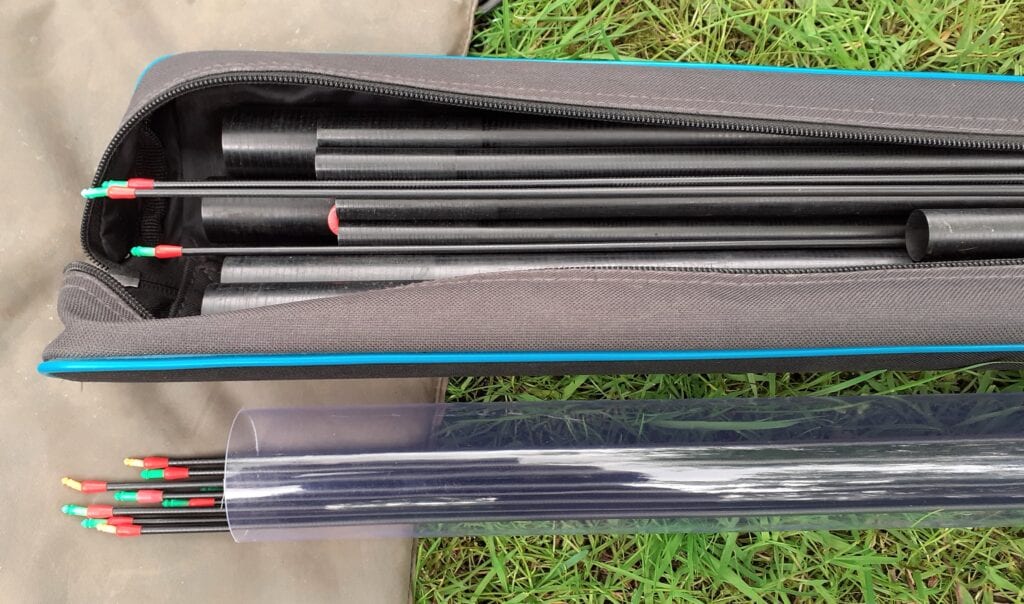
I used to keep all the spare top kits for my pole in plastic rod tubes, but I could only get a few kits in each one, having to lug around a big bundle in my holdall. This took up far too much space until I spotted a mate using a Drennan Top Kit Case. What a brilliant piece of luggage! I bought one straight away, and can now store a massive amount in a far more compact area, in a streamlined case that neatly slots inside my main holdall. The case is hard-sided and long enough to take assembled match top two kits, along with broken down top two power kits. Spare number three and four sections also slot in. I now have 12 various length kits in one place, freeing up a lot of room in my holdall. The only extra thing I needed was just one of the tubes I had previously, to house my lighter silver fish match top two kits. This new arrangement is much neater, making everything easier to locate. I don’t have to worry about taking important gear out now, to make extra room, and risk forgetting it next trip!
JOINT SAVERS
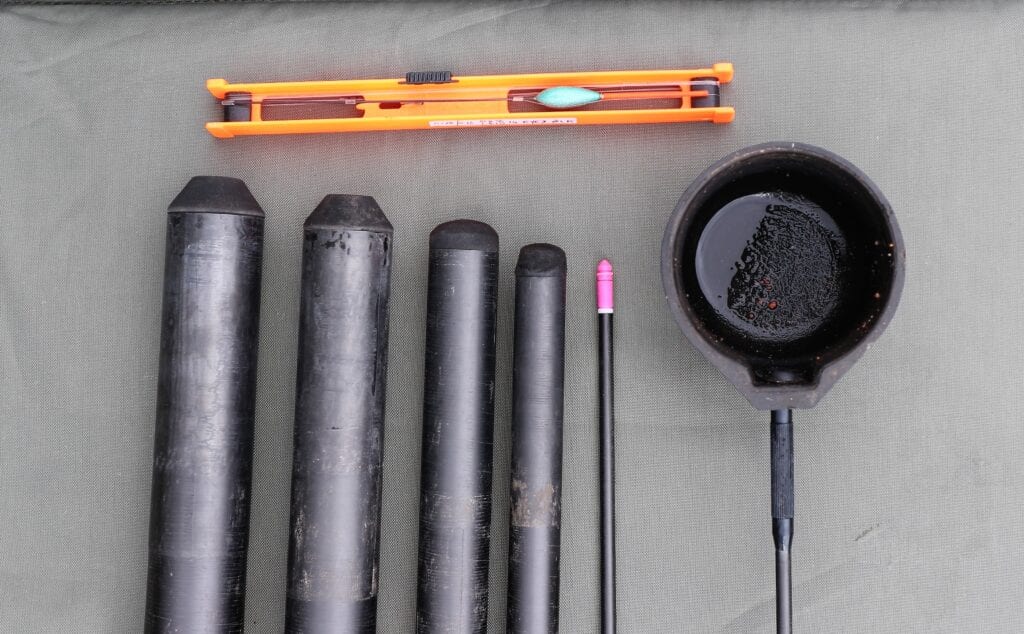
It amazes me how few anglers I see using joint protectors on their top end poles. I don’t think I could comfortably fish without these gismos. I prefer the EVA type, although you have to shop around to find the right sizes, which can be a major pain. Joint protectors prevent sections clashing while they are being pushed together, also reducing wear and tear. I kit out all my upper pole sections with them – the ones that are unshipped most often. I’ve also fitted joint protectors to my margin pole (in the accompanying photograph). Bigger base bungs are another form of protection for a pole’s lower butt sections, to prevent serious damage if they clash with anything, or come into contact with the ground. Large plastic end caps do a similar job, but with my long pole I use half-butt extensions. These are extremely robust, also preventing elbow damage on expensive lower pole sections, which can happen after a while, due to your forearm pressing into the carbon every time you lift it up.
SMOOTH RUNNING
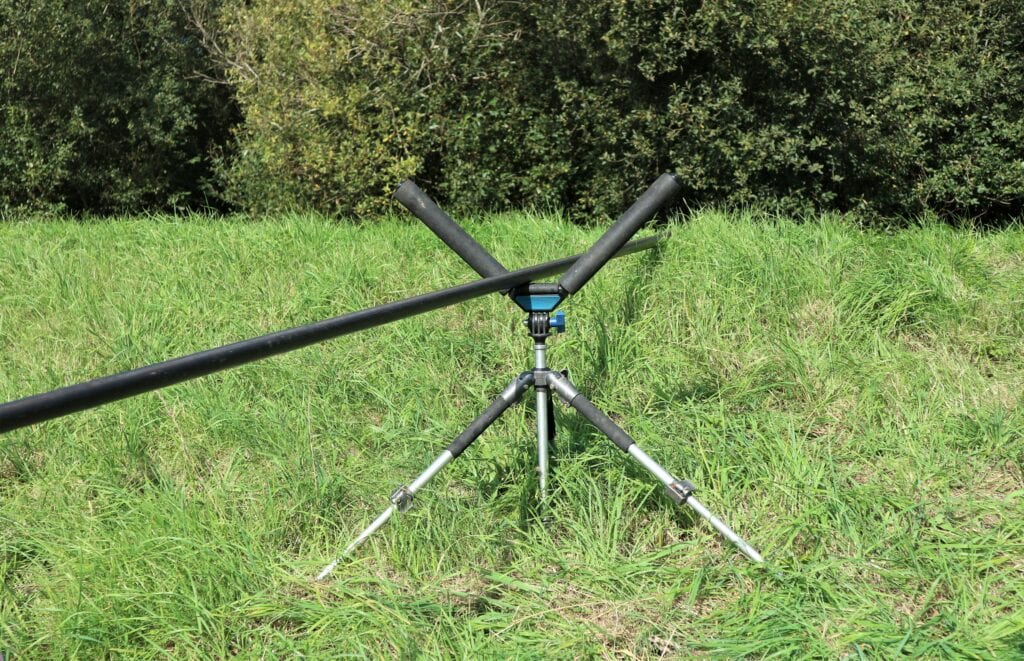
Long poles are expensive, and a good way to extend their lifespan is to keep everything running smoothly by using quality pole rollers. Apart from keeping your pole clean by having it elevated, there’s less risk of any damage occurring if sections aren’t allowed to scrape across hard ground. “V” rollers are better for high set usage, particularly when navigating pole sections over obstacles like high banks, boulders, fences, heavy undergrowth, and water (when sitting out in the margins). My V-roller has a tripod with telescopic legs and an adjustable central rod. This allows an amazing variety of heights to be achieved, particularly useful when fishing venues that have high banks to navigate. A single roller is okay if you are only going to break down a few sections, or if there is a grassy area behind, which butt sections can slide over once they have travelled past the roller. The only downside with V-shaped rollers is there is less to aim at, compared with wider flatbed designs.
DOUBLE TAKE
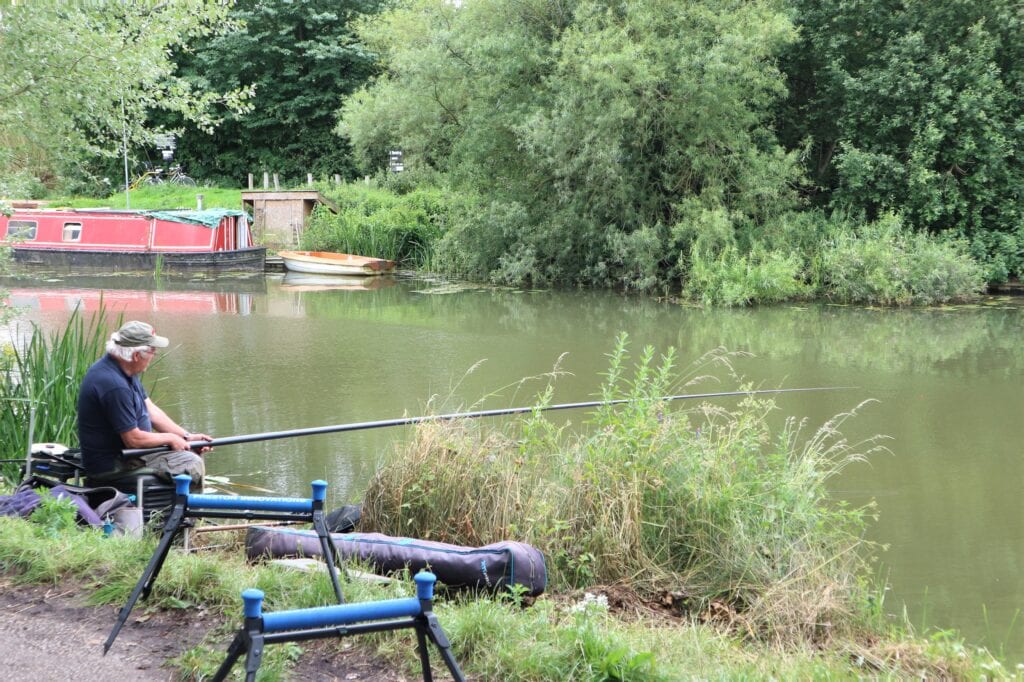
When the bank I’m fishing from is flat and free of obstacles, I prefer lower set flatbed rollers. I normally use two, keeping my pole sections completely suspended off the ground. I try to position double rollers in such a way that unshipped sections can’t roll anywhere, also having them set at an angle, so I can manoeuvre the pole sideways before unshipping it. This part is important because I want to gently steer any hooked fish away from the feed area before bringing the pole back. If something big and lively kites up to the surface, I don’t want it to disturb the main catching spot. If I’m fishing a venue that’s busy with passers-by, I position rollers even closer to the water’s edge, and bring the pole round a lot further before unshipping. This is something fishing canal towpaths has taught me, to avoid speeding bikers and joggers from smashing into expensive pole sections. A bit of extra thought setting up rollers makes a session run better and prevents costly accidents.
STRETCH FACTOR
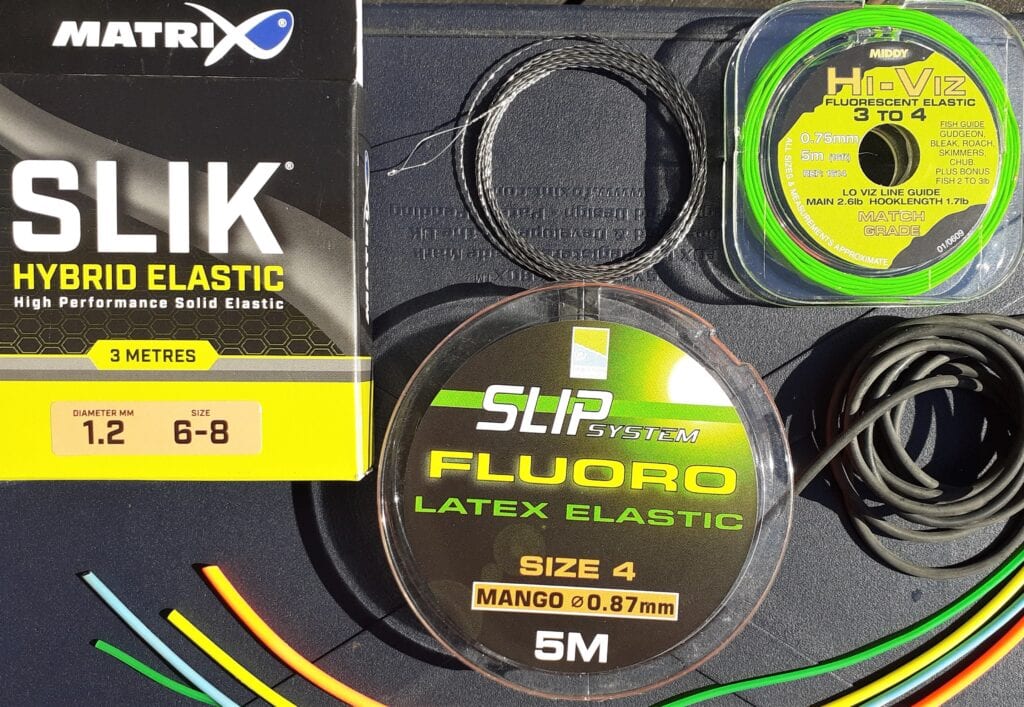
It seems the pole elastic you use is a personal thing. Many top pole anglers agree to disagree on what the best types are. I suspect some of this might be influenced by ties to tackle companies, while personally I tend to switch about between all the different types. Standard, good old-fashioned solid elastic is still good for all my light silver fish top kits. But once I step up to any rigs that have a chance of connecting with bigger fish, even if they are formed with light lines and fine hooks, I switch to the new breed of hybrid elastic. Although still solid, this stuff stretches so much further than anything else. Due to its incredible elasticity, I have fitted special mini puller bung systems to some of my match top kits, which I will explain a bit later. I also use hybrid elastics in my pole’s medium power top kits. But for out-and-out strength, I continue to trust hollow elastics for my really heavy rigs, still preferring Hydro in black and grey colours. Grey is stretchier, while black stops just about anything.
BUSH TYPES
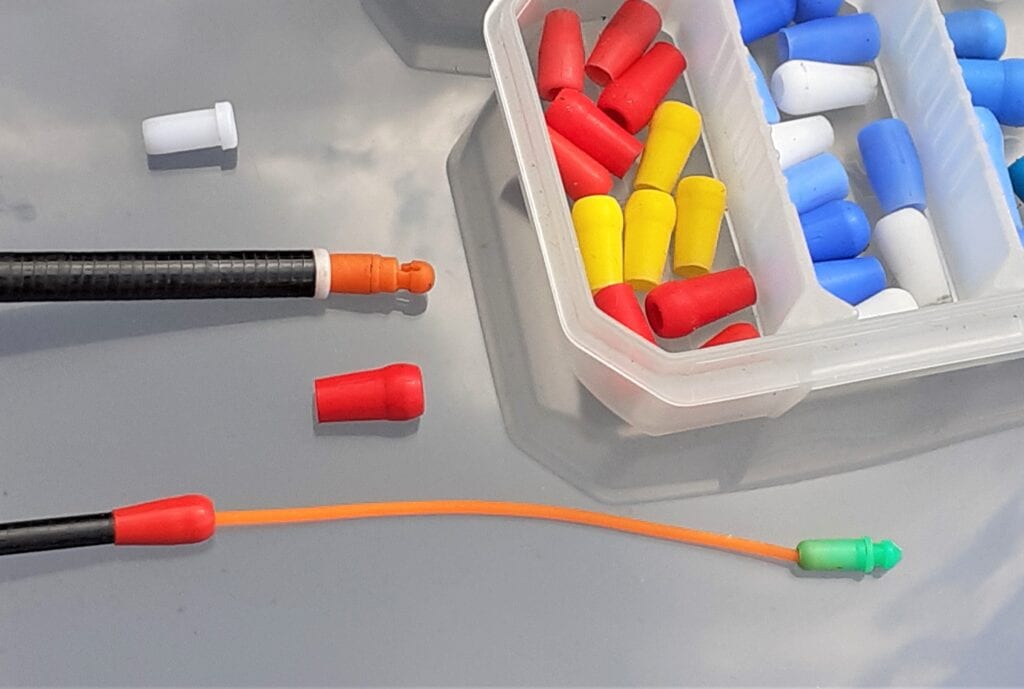
Again, the design of PTFE bushes used with different elastic gauges is mainly down to personal choice, but I have very firm views about this important part of pole fishing. The diameter of the bush needs to be just a tad bigger than the elastic size, otherwise an over-large elastic connector is required to stop it from jamming in the bush, or completely disappearing inside the pole’s top section. Over-big connectors can cause a bit of a bump on the strike and result in lost fish, so the smaller this is, the better. Generally, I use external bushes for most pole elastic diameters, only switching to internal designs for thicker hollow shock absorbers. In the latter instance, internals fit more neatly, while large diameter externals are bulky, risking line above the float catching back around them. I also like the way most external bushes are colour-coded, making it easy finding the right top kit for the job, while many internals are made from white PTFE and all look the same.
GETTING CONNECTED
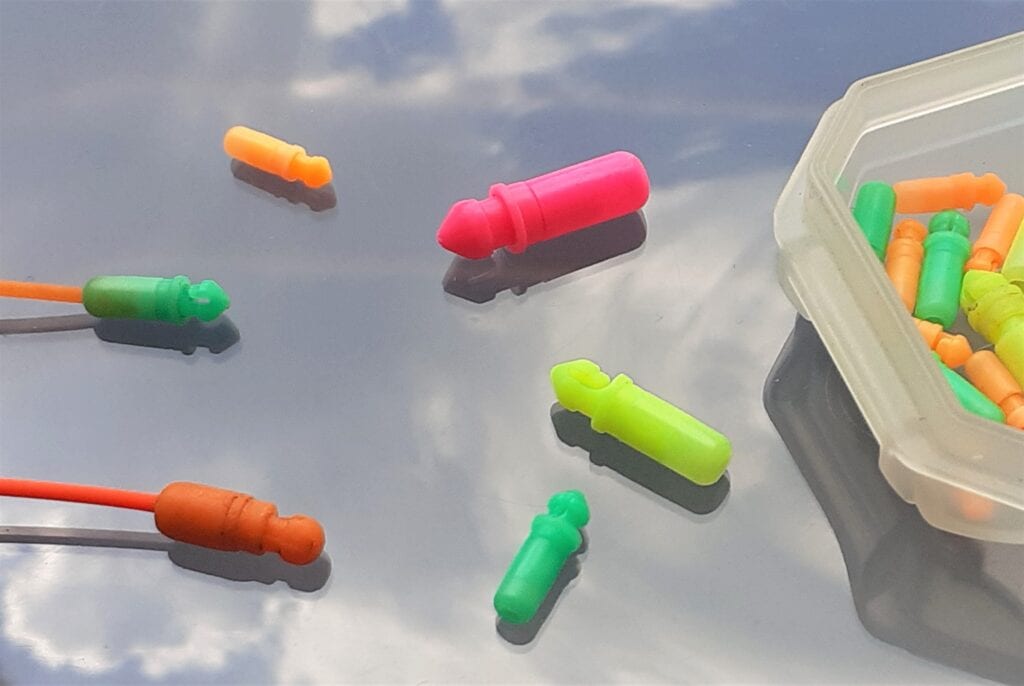
The trendiest type of elastic connectors at the moment are Dacron designs. This makes me chuckle because I was using something similar over 30 years ago, but have now gone back to plastic ones. The latter work fine as long as you use the smallest size you can get away with. You will only experience the bumping syndrome, which people worry about when striking, if you use over-large connectors (in relation to the diameter of elastic being used). I find plastic connectors neater and easier to use, providing the design in question locks together positively. I rate the Drennan ones best, because many other types work loose, risking losing the rig. I don’t use Dacron versions due to the way they stand off the tip of the pole, looking a bit awkward. It can also be fiddly having to loop rigs onto them, especially using double loops, so the tackle releases more easily. With light-line rigs in particular, it can be tricky removing them when you pack away, especially with cold, wet fingers.
BASIC BUNGS
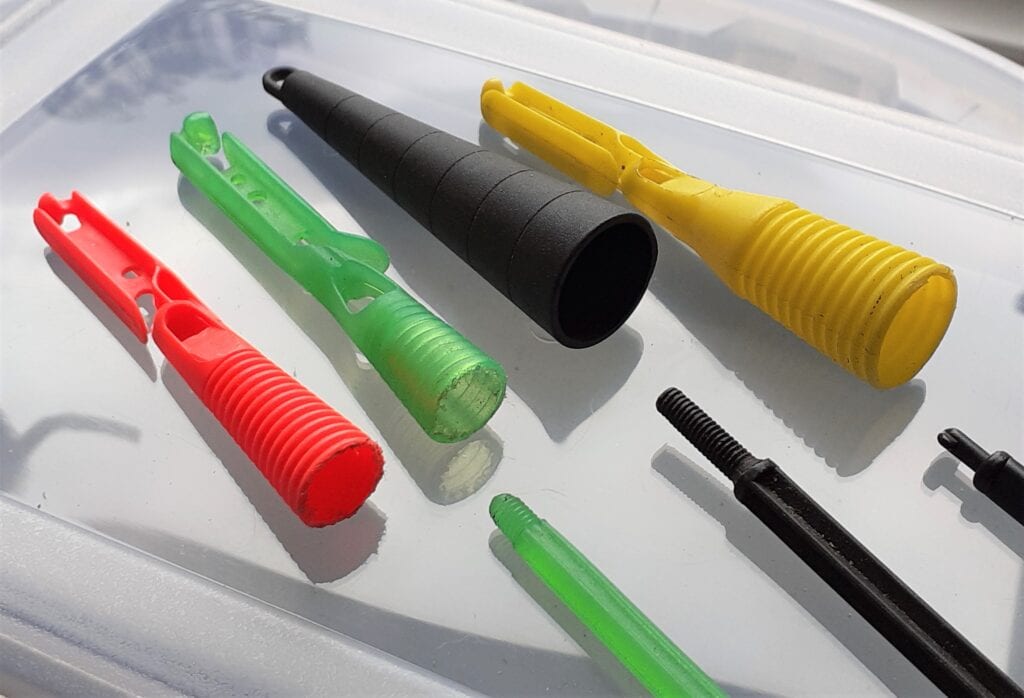
For all my top kits that don’t have puller systems fitted, I use a mixture of simple base bungs and winder bungs. The most basic type are combined with fine elastics, which rarely need tensioning up. The reason for this is I double up and twist the last 10cms of elastic just above the bung which, combined with using a good lubricant, prevents the shock absorber from ever drooping out of the pole. I do, however, use winder bungs with some elastics, because these might be used occasionally in extra deep water. In this situation the elastics work better tensioned up a bit, helping to connect more positively with bites. Winder bungs are okay, as long as you don’t store too much on them, otherwise your top kit can start to sag with the extra weight. The good thing about this type of bung is there is never any need to cut back pole elastics, so they can be returned to their original state after a session. As for elastic lubricant, I simply use hair conditioner, lightly diluted with water.
ELASTIC PROTECTORS
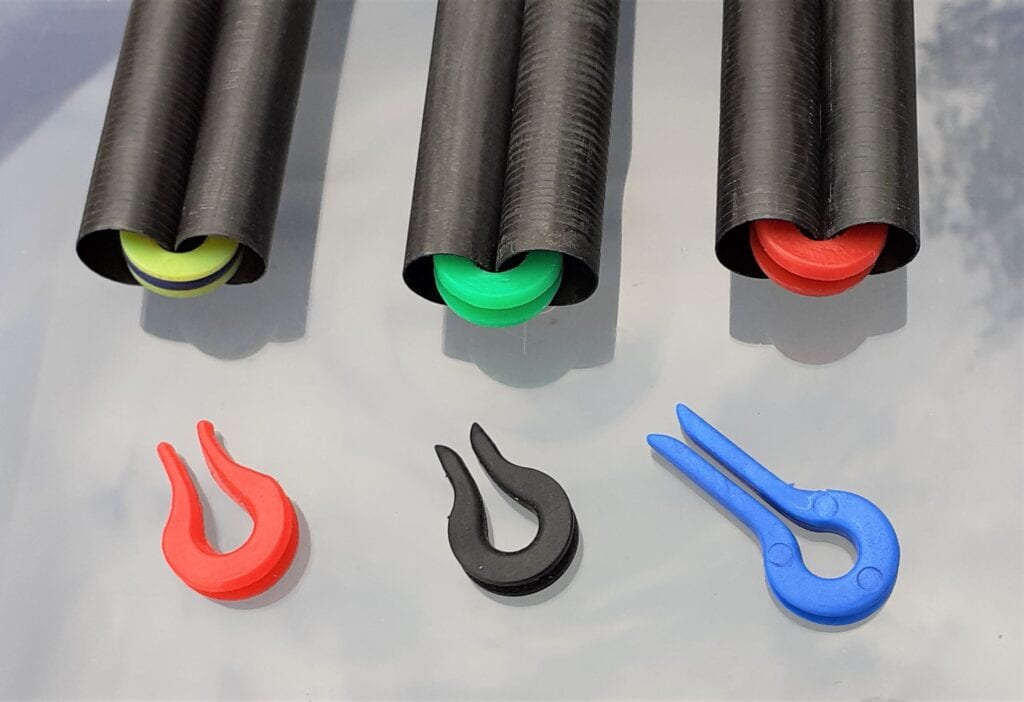
Elastic threaded through take-apart top two power kits can wear prematurely when they are stored away, due to regular movement in your rod holdall. This can result in the shock absorber snapping unexpectedly while playing a good fish. These simple horseshoe-shaped protectors prevent elastic from getting chafed, where it would otherwise come into contact with the sharp edges of broken-down pole sections. Risking damaging pole elastics, that can cost over a tenner for top-end hollow gear, is lazy and daft. These protectors also prevent elastics from getting kinked, which doesn’t help in keeping them smooth-running. Protectors help to clamp stored pole sections together, which keeps them from rattling about in transit, again reducing chances of anything getting damaged.
MINI PULLERS
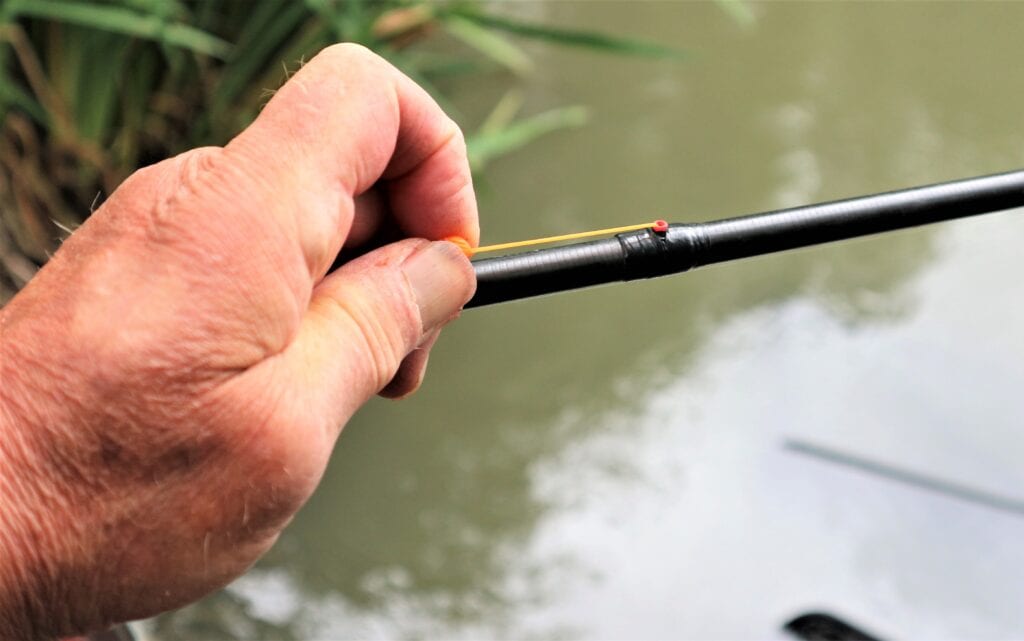
Before puller bungs and side bushes, it was common to have to play big fish on the pole with quite a few sections extended in the air, due to so much elastic coming into play. This occasionally resulted in expensive mid sections getting broken. Not any more. Puller kits allow you to break down to your stronger and shorter top two or three sections, where you can then quickly control how much elastic is outside the pole. This helps to land big fish much faster, with expensive lower pole sections well out of the way. I’ve now improvised a similar system with some of my match top kits, the ones fitted with hybrid elastic. Since I have been using the new breed of elastic, I have landed so many big bonus fish on light tackle. It has been a revelation, but the only problem has been gaining some control. Hook a stray carp on a silver fish rig and you can soon be playing it several pegs away. But with a puller kit you can coax fish like this back a lot quicker. I’ve reinforced and drilled some of my match top kits, aralditing in small PTFE bushes, to form mini puller systems. It works a treat.
MY WAY
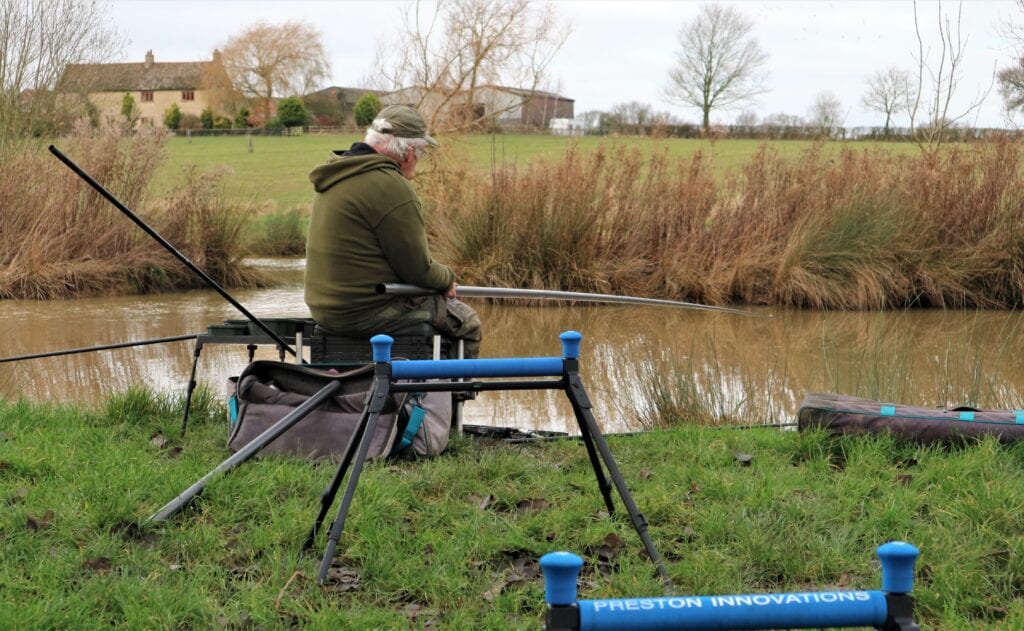
My fishing station might look busy, but it’s almost minimalist in relation to the huge amounts of gear I see many pole anglers using. Yes, I do often use two pole rollers, but I don’t like cluttering up my fishing position too much. That’s why I rarely use pole roosts, pole socks, or surround myself with numerous bait trays and accessory arms. I like to keep busy when fishing and this requires room to move! Apart from pole rollers, a simple free-standing bait table is often enough for me. I position this close to the legs on my seat box, so there’s just enough of a gap for my landing net handle to slot in. All I need then is to park my cupping kit and spare top kits. I normally have the base of the cup kit resting on my bait table for quick access. I try and keep any spare top kits shielded from passers-by, placing them close to the water, in front of my rod holdall. I will occasionally use a roost over rough or overgrown banks, or when fishing out in the water, but generally I don’t like it to look like I’m fishing from something that resembles an oil rig when I bring the pole into play!
The post Seeking Pole Perfection first appeared on FishingMagic Magazine.
Continue reading...
Pole fishing is one of the most precise ways of catching fish. It allows feeding and tackle presentation to be combined inch-perfectly, which goes a long way to producing consistent results. I will never forget how a good mate once described the way I was bagging up with a pole, calling it “industrial angling”. He is a top game fisherman, more used to the science of flies than dangling maggots on size 20 hooks for shy-biting roach. I was bagging up big-time, after working the fish into a feeding frenzy on hemp, quickly switching up the gears into match fishing mode. For a while I thought I had completely lost my friend back to the salmon and trout beats, suspecting pole fishing wasn’t his cup of tea. We lost touch for a while, due to me relocating, but eventually met up again. Surprise, surprise. Out of my pal’s holdall emerged an expensive long pole, with all the associated gear. Pole rollers were set up, then a cupping kit came into play. He had the whole caboodle and was loving it.
STORAGE SOLUTIONS

I used to keep all the spare top kits for my pole in plastic rod tubes, but I could only get a few kits in each one, having to lug around a big bundle in my holdall. This took up far too much space until I spotted a mate using a Drennan Top Kit Case. What a brilliant piece of luggage! I bought one straight away, and can now store a massive amount in a far more compact area, in a streamlined case that neatly slots inside my main holdall. The case is hard-sided and long enough to take assembled match top two kits, along with broken down top two power kits. Spare number three and four sections also slot in. I now have 12 various length kits in one place, freeing up a lot of room in my holdall. The only extra thing I needed was just one of the tubes I had previously, to house my lighter silver fish match top two kits. This new arrangement is much neater, making everything easier to locate. I don’t have to worry about taking important gear out now, to make extra room, and risk forgetting it next trip!
JOINT SAVERS

It amazes me how few anglers I see using joint protectors on their top end poles. I don’t think I could comfortably fish without these gismos. I prefer the EVA type, although you have to shop around to find the right sizes, which can be a major pain. Joint protectors prevent sections clashing while they are being pushed together, also reducing wear and tear. I kit out all my upper pole sections with them – the ones that are unshipped most often. I’ve also fitted joint protectors to my margin pole (in the accompanying photograph). Bigger base bungs are another form of protection for a pole’s lower butt sections, to prevent serious damage if they clash with anything, or come into contact with the ground. Large plastic end caps do a similar job, but with my long pole I use half-butt extensions. These are extremely robust, also preventing elbow damage on expensive lower pole sections, which can happen after a while, due to your forearm pressing into the carbon every time you lift it up.
SMOOTH RUNNING

Long poles are expensive, and a good way to extend their lifespan is to keep everything running smoothly by using quality pole rollers. Apart from keeping your pole clean by having it elevated, there’s less risk of any damage occurring if sections aren’t allowed to scrape across hard ground. “V” rollers are better for high set usage, particularly when navigating pole sections over obstacles like high banks, boulders, fences, heavy undergrowth, and water (when sitting out in the margins). My V-roller has a tripod with telescopic legs and an adjustable central rod. This allows an amazing variety of heights to be achieved, particularly useful when fishing venues that have high banks to navigate. A single roller is okay if you are only going to break down a few sections, or if there is a grassy area behind, which butt sections can slide over once they have travelled past the roller. The only downside with V-shaped rollers is there is less to aim at, compared with wider flatbed designs.
DOUBLE TAKE

When the bank I’m fishing from is flat and free of obstacles, I prefer lower set flatbed rollers. I normally use two, keeping my pole sections completely suspended off the ground. I try to position double rollers in such a way that unshipped sections can’t roll anywhere, also having them set at an angle, so I can manoeuvre the pole sideways before unshipping it. This part is important because I want to gently steer any hooked fish away from the feed area before bringing the pole back. If something big and lively kites up to the surface, I don’t want it to disturb the main catching spot. If I’m fishing a venue that’s busy with passers-by, I position rollers even closer to the water’s edge, and bring the pole round a lot further before unshipping. This is something fishing canal towpaths has taught me, to avoid speeding bikers and joggers from smashing into expensive pole sections. A bit of extra thought setting up rollers makes a session run better and prevents costly accidents.
STRETCH FACTOR

It seems the pole elastic you use is a personal thing. Many top pole anglers agree to disagree on what the best types are. I suspect some of this might be influenced by ties to tackle companies, while personally I tend to switch about between all the different types. Standard, good old-fashioned solid elastic is still good for all my light silver fish top kits. But once I step up to any rigs that have a chance of connecting with bigger fish, even if they are formed with light lines and fine hooks, I switch to the new breed of hybrid elastic. Although still solid, this stuff stretches so much further than anything else. Due to its incredible elasticity, I have fitted special mini puller bung systems to some of my match top kits, which I will explain a bit later. I also use hybrid elastics in my pole’s medium power top kits. But for out-and-out strength, I continue to trust hollow elastics for my really heavy rigs, still preferring Hydro in black and grey colours. Grey is stretchier, while black stops just about anything.
BUSH TYPES

Again, the design of PTFE bushes used with different elastic gauges is mainly down to personal choice, but I have very firm views about this important part of pole fishing. The diameter of the bush needs to be just a tad bigger than the elastic size, otherwise an over-large elastic connector is required to stop it from jamming in the bush, or completely disappearing inside the pole’s top section. Over-big connectors can cause a bit of a bump on the strike and result in lost fish, so the smaller this is, the better. Generally, I use external bushes for most pole elastic diameters, only switching to internal designs for thicker hollow shock absorbers. In the latter instance, internals fit more neatly, while large diameter externals are bulky, risking line above the float catching back around them. I also like the way most external bushes are colour-coded, making it easy finding the right top kit for the job, while many internals are made from white PTFE and all look the same.
GETTING CONNECTED

The trendiest type of elastic connectors at the moment are Dacron designs. This makes me chuckle because I was using something similar over 30 years ago, but have now gone back to plastic ones. The latter work fine as long as you use the smallest size you can get away with. You will only experience the bumping syndrome, which people worry about when striking, if you use over-large connectors (in relation to the diameter of elastic being used). I find plastic connectors neater and easier to use, providing the design in question locks together positively. I rate the Drennan ones best, because many other types work loose, risking losing the rig. I don’t use Dacron versions due to the way they stand off the tip of the pole, looking a bit awkward. It can also be fiddly having to loop rigs onto them, especially using double loops, so the tackle releases more easily. With light-line rigs in particular, it can be tricky removing them when you pack away, especially with cold, wet fingers.
BASIC BUNGS

For all my top kits that don’t have puller systems fitted, I use a mixture of simple base bungs and winder bungs. The most basic type are combined with fine elastics, which rarely need tensioning up. The reason for this is I double up and twist the last 10cms of elastic just above the bung which, combined with using a good lubricant, prevents the shock absorber from ever drooping out of the pole. I do, however, use winder bungs with some elastics, because these might be used occasionally in extra deep water. In this situation the elastics work better tensioned up a bit, helping to connect more positively with bites. Winder bungs are okay, as long as you don’t store too much on them, otherwise your top kit can start to sag with the extra weight. The good thing about this type of bung is there is never any need to cut back pole elastics, so they can be returned to their original state after a session. As for elastic lubricant, I simply use hair conditioner, lightly diluted with water.
ELASTIC PROTECTORS

Elastic threaded through take-apart top two power kits can wear prematurely when they are stored away, due to regular movement in your rod holdall. This can result in the shock absorber snapping unexpectedly while playing a good fish. These simple horseshoe-shaped protectors prevent elastic from getting chafed, where it would otherwise come into contact with the sharp edges of broken-down pole sections. Risking damaging pole elastics, that can cost over a tenner for top-end hollow gear, is lazy and daft. These protectors also prevent elastics from getting kinked, which doesn’t help in keeping them smooth-running. Protectors help to clamp stored pole sections together, which keeps them from rattling about in transit, again reducing chances of anything getting damaged.
MINI PULLERS

Before puller bungs and side bushes, it was common to have to play big fish on the pole with quite a few sections extended in the air, due to so much elastic coming into play. This occasionally resulted in expensive mid sections getting broken. Not any more. Puller kits allow you to break down to your stronger and shorter top two or three sections, where you can then quickly control how much elastic is outside the pole. This helps to land big fish much faster, with expensive lower pole sections well out of the way. I’ve now improvised a similar system with some of my match top kits, the ones fitted with hybrid elastic. Since I have been using the new breed of elastic, I have landed so many big bonus fish on light tackle. It has been a revelation, but the only problem has been gaining some control. Hook a stray carp on a silver fish rig and you can soon be playing it several pegs away. But with a puller kit you can coax fish like this back a lot quicker. I’ve reinforced and drilled some of my match top kits, aralditing in small PTFE bushes, to form mini puller systems. It works a treat.
MY WAY

My fishing station might look busy, but it’s almost minimalist in relation to the huge amounts of gear I see many pole anglers using. Yes, I do often use two pole rollers, but I don’t like cluttering up my fishing position too much. That’s why I rarely use pole roosts, pole socks, or surround myself with numerous bait trays and accessory arms. I like to keep busy when fishing and this requires room to move! Apart from pole rollers, a simple free-standing bait table is often enough for me. I position this close to the legs on my seat box, so there’s just enough of a gap for my landing net handle to slot in. All I need then is to park my cupping kit and spare top kits. I normally have the base of the cup kit resting on my bait table for quick access. I try and keep any spare top kits shielded from passers-by, placing them close to the water, in front of my rod holdall. I will occasionally use a roost over rough or overgrown banks, or when fishing out in the water, but generally I don’t like it to look like I’m fishing from something that resembles an oil rig when I bring the pole into play!
The post Seeking Pole Perfection first appeared on FishingMagic Magazine.
Continue reading...
